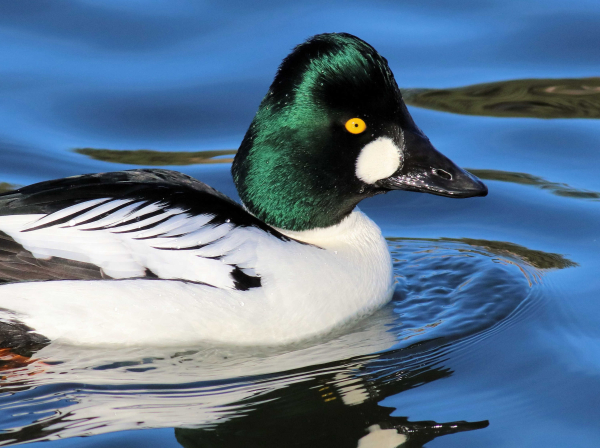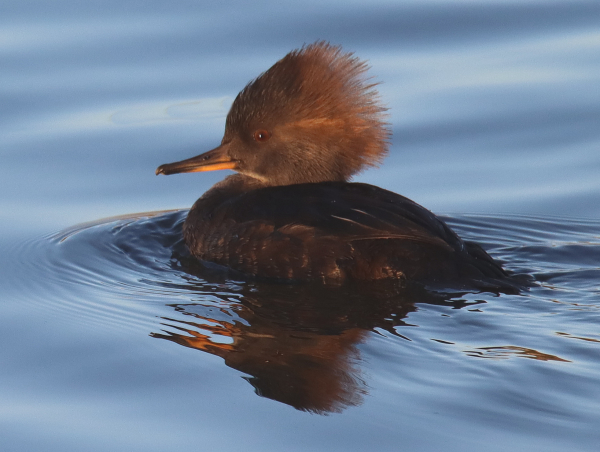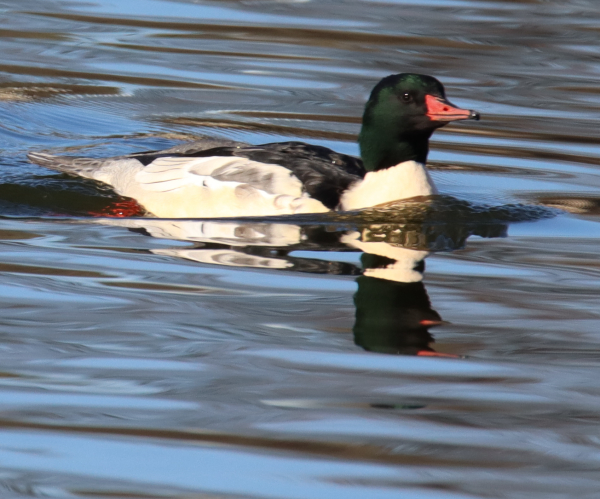
Open water along the back bays of the Missouri River provide cold weather habitat for some hardy ducks, including Common Goldeneyes.

Other open water ducks included Hooded Mergansers (above), Common Mergansers (below), Redheads, and many Mallards in the Pierre area.

|
As I signed off last week, I was poised to do the first survey of birds at my SoDak Winter Raptor Hotspot centered in Pierre, South Dakota. Tuesday proved to be especially exciting during a beautiful day, and I counted a nice diversity of 8 raptor species, and a surprising total of 51 birds of prey considering it was early in the season. My raptor hotspot is really a series of connected transects that I drive to identify and count all the birds along the way, while taking advantage of photo opportunities – it’s always exciting and rewarding ‘cuz ya never know what’s around the next turn!
There was no snow cover beginning north of Pierre, which meant the birds were not concentrated yet, but raptor sightings were steady along the way and added up nicely. Even so, some of the best areas for raptors in the past yielded few sightings during this early survey. Overall though, the totals were good and the birds supplied interesting sightings, and a few photos – such an enjoyable way to spend a warm sunny day.
Throughout the SoDak transect areas I counted 13 Bald Eagles, 3 Golden Eagles, 12 Rough-legged Hawks (including 2 dark morphs), 14 Red-tailed Hawks (including a light morph Harlan’s Red-tail), 1 Ferruginous Hawk, 5 Northern Harriers, 2 Merlins, and 1 American Kestrel – a total of 51 raptors. A few notes to share: 51 is a high total for this early start to the raptor wintering season, about 15 higher than other pre-Thanksgiving counts, which is interesting considering that most of the area has no snow cover, which tends to concentrate more birds in the area. No Prairie Falcons were sighted, there were few Golden Eagles, and there was a low total of Rough-legged Hawks, but numbers of those species will surely increase as the season progresses and there is more snow cover in the state. All Red-tails were sighted within 10 miles of Pierre or farther south.
It was especially interesting to see certain “marked” individuals, birds with rare plumage coloration that makes them identifiable as individuals during a season if they stay at a location, and year after year if they return. These included 3 hawks last week, the 2 dark morph Rough-legged Hawks and the light morph Harlan’s Red-tail, all of which returned to winter territories they inhabited last year and a number of previous winters. To see photos of the Harlan’s and some other Red-tails encountered, you can refer to the Bird Photography feature in this issue.
There were other birds observed during the SoDak counts, but not many of them; foremost was my first sighting of a Northern Shrike for the season, along with a lone Western Meadowlark and a small flock of 5 others, 4 scattered male Ring-necked Pheasants, and a Blue Jay. Within the cities of Pierre and Fort Pierre, it might seem that Canada Geese have taken over many urban areas, and there is open water that is keeping a few Hooded Mergansers, Common Mergansers, Common Goldeneyes, Redheads, and many Mallards in the area, along with a Double-crested Cormorant and a few Ring-necked Gulls. Overall it was a great getaway to take advantage of some nice late fall days.
Local Birds
Closer to home, during a local search Wednesday I was surprised by another flock of Gray Partridges numbering 6 in all. Among the scant birds to be seen was a flock of 7 Ring-necked Pheasants (1 female and 6 males), and a few hundred yards from my office I observed 3 active American Robins – a species I haven’t seen for some weeks. A brief Thanksgiving drive offered only pheasants: 2 males ½ mile north, with 1 crowing as I passed by. A hen pheasant was evident a few miles north, as were 3 scattered lone males as I drove 3-miles south, including 1 that crowed loudly as I photographed it flying, then landing. A Sunday afternoon cruise was birdless to the south, but a hen pheasant turned up 8 miles north, and as I returned I sighted 5 Ring-necks on the ice of a frozen marsh. It’s lean times in the neighborhood for this birder.
Bismarck Bound
Although sightings of birds in the open plains are remarkably rare this far north now, the birds on hand tend to be especially notable. On my way to Bismarck I drove a route I considered the best bet to try to find my first Snowy Owl of the year. After a half-hour’s drive I spied a male Rough-legged Hawk perched on a lone snag, and a couple miles farther east a tan Merlin showed its dynamic falcon shape in fight above a prairie wetland. I stopped to try to follow its progress, but lost sight of it instead – oh well. A half-hour later a Bald Eagle flew perpendicular to my drive, adding to the light raptor count. After that a couple flocks of hen pheasants were the only other birds to be seen – 6 feeding in Asian olive trees and 3 feeding along a railroad crossing.
When I reached the capitol city I decided to continue across the Missouri River to venture north of the sister city of Mandan to see how far housing had crept into the countryside around a ranch where I worked during high school. Houses were actually still widely scattered, but while I was looking for Wild Turkeys that day after Thanksgiving along the Missouri Breaks I found 3 duos of Black-billed Magpies and a trio of American Crows, plus a couple flocks of Canada Geese flying back to the open water of the river, but no turkeys or raptors were evident.
Next I cruised south of Bismarck where I knew I could find turkeys, but the first bird sighted was a surprise Red-tailed Hawk, pretty rare even along the wooded river bottoms by the time snow arrives. Next were 5 Wild Turkeys on the edge of an opening in the undergrowth, just as a remarkable sunset was progressing with wispy clouds lighting up from horizon to horizon in white, then yellow, then pink, followed by deep orange-red.
Window Birds
Action at my feeding station has been very predictable the past couple weeks, with the same species and probably the same birds winging in daily – except that the Dark-eyed Juncos left over the course of a couple days until the last one vanished about 10 days ago. That left the Blue Jays, Red-breasted and White-breasted Nuthatches, House Finches, Downy Woodpeckers, and occasional Hairy Woodpeckers to distract me from writing and editing, which is a good thing – ha.
But ya never know what excitement might fly into view next, and that’s always part of the excitement of birding – at home or in the field – the potential of a bird that takes your breath away and gives you something to share with fellow birders and friends. I hope you enjoy those kinds of breathless experiences often during December.
Article and photos by Paul Konrad
Share your bird sightings and photographs at editorstbw2@gmail.com